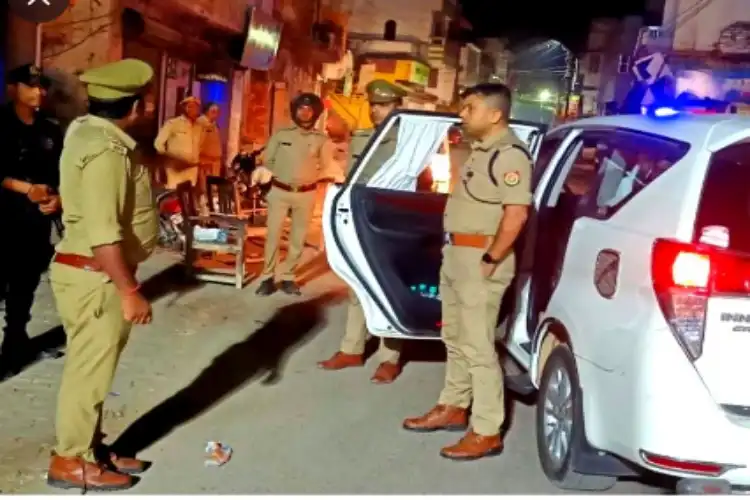
Saquib Salim
While scrolling through my Twitter timeline, I came across a Tweet by the Ayodhya Police where the senior Suprintendent of Police (SSP), Ayodhya Shailesh Pandey was briefing the media about the arrest of seven anti-sopcial person involved in a conspiracy to desecrate religious places with the aim of fanning communal tensions in Ayodhya just before Id-ul-Fitr (Eid). As I read through the police statement and followed the action they took I became emotional and my thoughts went to massacre of Muslims by police at Moradabad Idgah in 1980.
On 13 August 1980, more than 40,000 Muslims gathered at Moradabad Idgah to offer prayers. It was an occasion of festivities and nobody would have thought that this Eid would become one of the bloodiest in history. After the namaz as dua was offered some anti-social elements, like those caught in Ayodhya, let loose a pig among namazis. When people asked the police to remove the pig, instead of helping the situation the police fired upon the namazis. 300 were killed by the police. MJ Akbar, now a BJP MP, who covered this massacre as a journalist wrote, “the incident at Moradabad was not a Hindu-Muslim riot but a calculated, cold-blooded massacre of Muslims by a rabidly communal police force which tried to cover up its genocide by making it out to be a Hindu-Muslim riot.”
The fact that local MLA Hafiz Mohammad Siddique was also among the namazis could not deter the police from killing the very people it was supposed to serve. Instead, the police, as well as the media, tried to blame the namazis for the massacre. The Times of India and Economic & Political Weekly claimed that the police were forced to fire as retaliation after the namazis attacked. Romesh Thapar, a well-known journalist and brother of historian Romila Thapar, claimed that foreign funds fuelled the separatist tendencies among Muslims. Another national daily ran a headline claiming that the Muslims had killed five BSF soldiers - and it was refuted by BSF. Several newspapers indulged in rumourmongering to give credibility to the police version.
Syed Shahabuddin, a former MP, and MJ Akbar punctured the concocted story put foprth by the police and backed by the media. Shahabuddin in a letter to the Economic & Political Weekly asked that if the police is correct in stating that namazis fired at the police then why;
“1. No firearms were seen coming into the Eidgah
2. No spent cartridges were found
3. No policeman received any bullet or pellet injury
4. No building opposite the Eidgah has any bullet marks
5. No firearms were left behind, despite the stampede
6. If the provocateurs were armed, why should they have brick-batted?”
The fact remained that the police instead of controlling an incident related to a stray pig created by antisocial criminals, blamed the Muslims and then punished them with a massacre where almost 300 people died. To hide its crimes the police blamed this on Hindu Muslim riots. Akbar wrote, “The most heartening thing I found about Moradabad was that, despite the intense provocation, the Hindus and the Muslims of the city were not spitting hate at each other.”
I have read all these accounts of police brutality in detail and wondered what if our police had behaved civilly. It is a fact that because of such incidents, which were not rare in the 1970s, 80s, or 90s, poor, less educated, and backward people did not trust the police. Akbar wrote, “The (Provincial Armed Constabulary) PAC, which in the past has already been condemned by inquiry commissions for partisanship, now has given Muslims one more very good reason to distrust it.”
Today, when I read this news from Ayodhya the tears rolled down my eyes with emotions that were an amalgam of sorrow, delight and hope. Of course, the grief of losing Indians 42 years back in the massacre outweighs every other emotion but then it is a matter of exultation that after four decades the same UP Police has done tremendous course correction. This time when miscreants tried to flare up communal frenzies, the police, unlike in 1980, did not blame it on Muslims and took punitive action against the victims. The police filed the complaint, worked towards maintaining calm, and arrested the culprits within 24 hours.
I wonder if the police could have maintained the same attitude during 1980 Moradabad when namazis offering Eid prayers were massacred. UP Police should be commended for this huge course correction. With stains like Moradabad, Hashimpura, Maliana, Aligarh, etc. in its past such swift and balanced action against the miscreants will win the UP Police the confidence of the poor and backward of the society.
